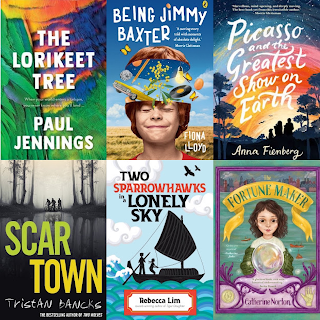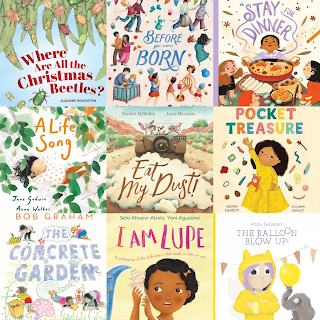Momotimetoread began in 2008 and now it is 2023. This has been an interesting reading year. I blogged nearly every day and thanks to the wonderful library I visit each week, I found some special book treasures. I did devote quite a few posts to books published in 2022 from Australia which were either sent to me for judging (Children's Book Council of Australia Picture Book and New Illustrator) or books that won our CBCA award in 2023. I have not listed these in this summary post. I was not permitted to talk about the 2022 Picture Book entries until our CBCA awards were announced in August. You can use the CBCA label from my sidebar to explore these.
In this list today you can expect to find books from around the world (especially USA, UK and Canada) because I believe we are so lucky here in Australia - we can share books from any country where they speak English and also there are a wealth of translated books each year which are often wonderful discoveries. Not every book listed here was published in 2023 but these were books I read or discovered. Sometimes it takes a while for an international title to reach us here in Australia and I also mostly wait for the paperback editions of US and UK titles which also take time to arrive.
I blogged just over 440 books this year and I have reached 1.3+ million page views.
Books I enjoyed the most:
Tyger by SF Said illustrated by Dave McKean
Impossible Creatures by Katherine Rundell
Summer of the Gypsy Moths by Sara Pennypacker
Willodeen by Katherine Applegate illustrated by Charles Santoso
The Summer We Found the Baby by Amy Hest
A Place to Hang the Moon by Kate Albus
Long Road to the Circus by Betsy Bird illustrated by David Small
Maizy Chen's Last Chance by Lisa Yee
Surprise discoveries:
The Secret of the Magic Pearl by Elisa Sabatinelli illustrated by Iacopo Bruno
The Eyes and the Impossible by Dave Eggers
Some Questions about Trees by Toni Yuly (Picture Book)
Ajay and the Jaipur Moon by Varsha Shah
The Elephant in the Room by Holly Goldberg Sloan
Alone by Megan E Freeman (Verse Novel)
The Fortune Maker by Catherine Norton
Two Sparrowhawks in a Lonely Sky by Rebecca Lim
Picasso and the Greatest Show on Earth by Anna Fienberg
Being Jimmy Baxter by Fiona Lloyd
The Lorikeet Tree by Paul Jennings
Best Australian Picture books:
The Balloon Blow up by Andy Geppert
Eat my Dust by Neridah McMullin illustrated by Lucinda Gifford (Biography)
Pocket Treasure by Wendy Shurety illustrated by Juliana Oakley
The Concrete Garden by Bob Graham
I am Lupe by Sela Ahosivi-Atiola illustrated by Yani Agustina
A Life Song by Jane Godwin illustrated by Anna Walker
Stay for Dinner by Sandhya Parappukkaran illustrated by Michelle Pereira
Before you were Born by Katrina Germein illustrated by Helene Magisson
Cub and Brown by Edwina Wyatt illustrated by Evie Barrow (junior novel)
A small sample of some of the best International Picture Books:
Who lives here? by Julia Donaldson
Knight Owl by Christopher Denise
The Barnabus Project by The Fan Brothers
Lizzy and the Cloud by The Fan Brothers
Most interesting Australian Non-Fiction Book
Australia: Country of Colour by Jess Racklyeft
Books I hope teachers will read aloud:
Dogtown by Katherine Applegate
Leeva at Last by Sara Pennypacker illustrated by Matthew Cordell
The Lost library by Rebecca Stead and Wendy Mass
Favourite illustrations:
Night Lunch by Eric Fan illustrated by Diana Seiferling
The Baker by the Sea by Paula White
Poppy's House by Karla Courtney illustrated by Madeline Kloepper
Pigeon and Cat by Edward Hemingway
Best verse novels:
Under a broken Sky by Mariko Nagai
Alias Anna by Susan Hood and Greg Dawson
The Way of Dog by Zana Fraillon
Here is a tiny sample of the books I really want to see in 2024. I also plan to add more graphic novels to my diet - I need to experience more titles in this form.
These are from my shop wishlist which has 450+ titles - yes, it is a little out of control:
Peng's Vase: A Chinese Folktale by Paolo Proietti illustrated by Angus Yuen-Killick
Oh, Sal by Kevin Henkes
The Wild Robot Protects by Peter Brown
The probability of everything by Sara Everett
Simon sort of Says by Erin Bow
Gold by Jed Alexander (and also his two other wordless books: Olive and Red)
Rise Up with a Song: The True Story of Ethel Smyth, Suffragette Composer by Diane Worthey illustrated by Helena Perez Garcia
The School for Whatnots by Margaret Peterson Haddix
The Little Green Envelope by Gillian Sze illustrated by Claudine Crangle
Escape to the River Sea by Emma Carroll
Birdsong by the Billabong by Maura Finn illustrated by Cate James





















































